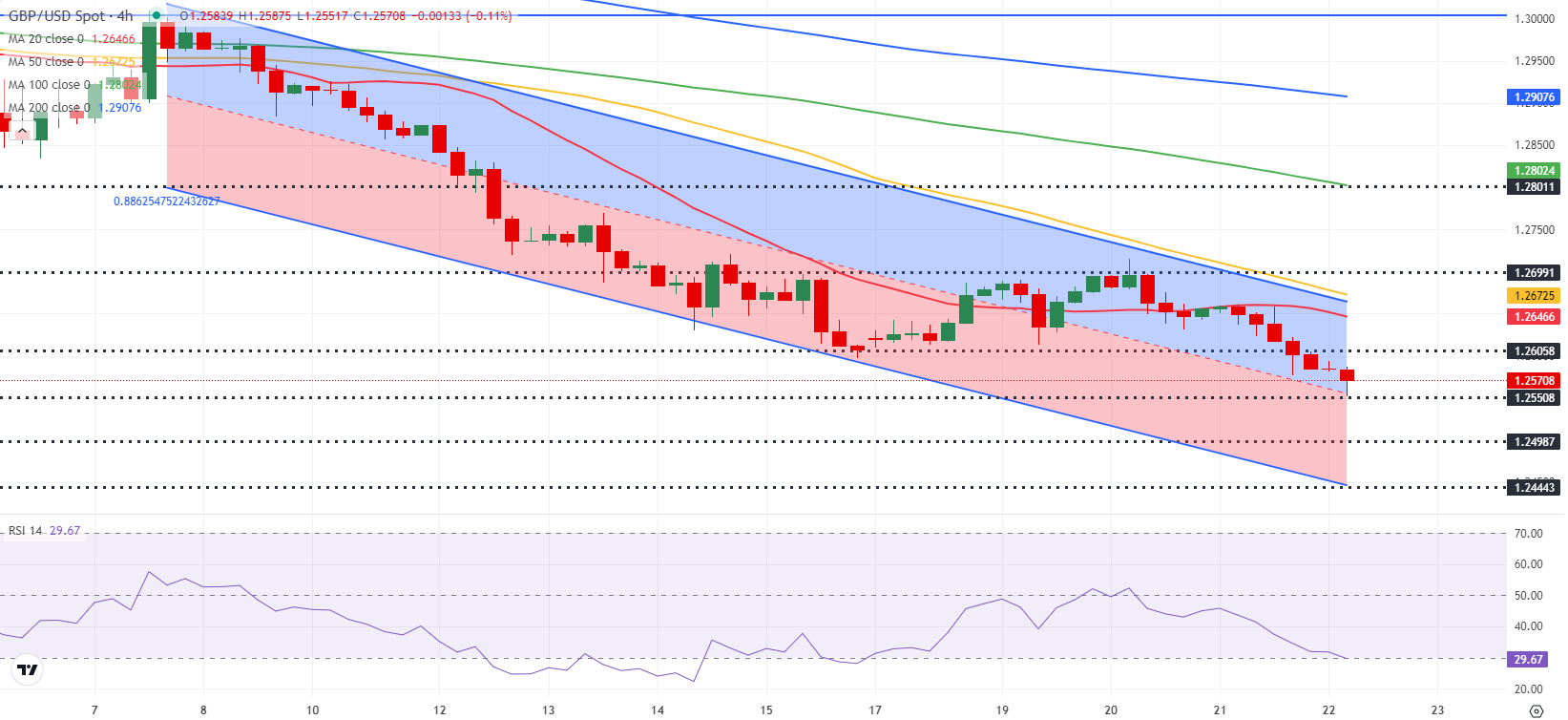- GBP/USD slumped to its lowest level since May below 1.2600.
- Disappointing UK Retail Sales data weighs on Pound Sterling early Friday.
- Flash estimates for November PMI from the UK and the US will be watched closely.
After losing 0.5% on Thursday, GBP/USD continued to push lower in the Asian session on Friday and touched its lowest level since May near 1.2550. The pair seems to have turned technically oversold but recovery attempts could remain short-lived in the near term.
British Pound PRICE This week
The table below shows the percentage change of British Pound (GBP) against listed major currencies this week. British Pound was the weakest against the Canadian Dollar.
| USD | EUR | GBP | JPY | CAD | AUD | NZD | CHF | |
|---|---|---|---|---|---|---|---|---|
| USD | 0.53% | 0.39% | 0.36% | -0.84% | -0.66% | 0.48% | -0.23% | |
| EUR | -0.53% | 0.03% | -0.06% | -1.25% | -1.03% | 0.06% | -0.65% | |
| GBP | -0.39% | -0.03% | -0.10% | -1.28% | -1.07% | 0.03% | -0.69% | |
| JPY | -0.36% | 0.06% | 0.10% | -1.20% | -0.95% | 0.17% | -0.52% | |
| CAD | 0.84% | 1.25% | 1.28% | 1.20% | 0.20% | 1.32% | 0.60% | |
| AUD | 0.66% | 1.03% | 1.07% | 0.95% | -0.20% | 1.11% | 0.39% | |
| NZD | -0.48% | -0.06% | -0.03% | -0.17% | -1.32% | -1.11% | -0.71% | |
| CHF | 0.23% | 0.65% | 0.69% | 0.52% | -0.60% | -0.39% | 0.71% |
The heat map shows percentage changes of major currencies against each other. The base currency is picked from the left column, while the quote currency is picked from the top row. For example, if you pick the British Pound from the left column and move along the horizontal line to the US Dollar, the percentage change displayed in the box will represent GBP (base)/USD (quote).
The persistent US Dollar (USD) strength weighed on GBP/USD during the American trading hours on Thursday. The US Department of Labor reported that the weekly Initial Jobless Claims declined to 213,000 from 219,000, boosting the USD. Additionally, Federal Reserve Bank of Chicago President Austan Goolsbee said that it may make sense to slow the pace of interest rate cuts as they get close to where rates will settle, further supporting the currency.
Early Friday, the UK's Office for National Statistics (ONS) announced that Retail Sales declined 0.7% on a monthly basis in October. This reading followed the 0.1% increase recorded in September and came in worse than the market expectation for a decline of 0.3%, making it difficult for Pound Sterling to stay resilient against its major rivals.
Later in the session, S&P Global/CIPS will publish preliminary November Purchasing Managers Index (PMI) data for the UK. Markets expect the Composite PMI to match October's final reading of 51.8. A positive surprise in this data could help GBP/USD find a foothold. On the flip side, a print below 50 could trigger another leg lower in the pair.
In the American session, S&P Global will also release PMI data for the US. If the Manufacturing PMI recovers above 50, the USD could continue to outperform its rivals heading into the weekend.
GBP/USD Technical Analysis
The Relative Strength Index (RSI) indicator on the 4-hour chart stays slightly below 30. In case the pair stages a technical correction, 1.2600 (former support, static level) could be seen as immediate resistance before 1.2670 (50-period Simple Moving Average (SMA), upper limit of the descending regression channel) and 1.2700 (round level, static level).
On the downside, 1.2550 (mid-point of the descending channel) aligns as first support ahead of 1.2500 (round level, static level) and 1.2440 (lower limit of the descending channel).
Pound Sterling FAQs
The Pound Sterling (GBP) is the oldest currency in the world (886 AD) and the official currency of the United Kingdom. It is the fourth most traded unit for foreign exchange (FX) in the world, accounting for 12% of all transactions, averaging $630 billion a day, according to 2022 data. Its key trading pairs are GBP/USD, also known as ‘Cable’, which accounts for 11% of FX, GBP/JPY, or the ‘Dragon’ as it is known by traders (3%), and EUR/GBP (2%). The Pound Sterling is issued by the Bank of England (BoE).
The single most important factor influencing the value of the Pound Sterling is monetary policy decided by the Bank of England. The BoE bases its decisions on whether it has achieved its primary goal of “price stability” – a steady inflation rate of around 2%. Its primary tool for achieving this is the adjustment of interest rates. When inflation is too high, the BoE will try to rein it in by raising interest rates, making it more expensive for people and businesses to access credit. This is generally positive for GBP, as higher interest rates make the UK a more attractive place for global investors to park their money. When inflation falls too low it is a sign economic growth is slowing. In this scenario, the BoE will consider lowering interest rates to cheapen credit so businesses will borrow more to invest in growth-generating projects.
Data releases gauge the health of the economy and can impact the value of the Pound Sterling. Indicators such as GDP, Manufacturing and Services PMIs, and employment can all influence the direction of the GBP. A strong economy is good for Sterling. Not only does it attract more foreign investment but it may encourage the BoE to put up interest rates, which will directly strengthen GBP. Otherwise, if economic data is weak, the Pound Sterling is likely to fall.
Another significant data release for the Pound Sterling is the Trade Balance. This indicator measures the difference between what a country earns from its exports and what it spends on imports over a given period. If a country produces highly sought-after exports, its currency will benefit purely from the extra demand created from foreign buyers seeking to purchase these goods. Therefore, a positive net Trade Balance strengthens a currency and vice versa for a negative balance.
Information on these pages contains forward-looking statements that involve risks and uncertainties. Markets and instruments profiled on this page are for informational purposes only and should not in any way come across as a recommendation to buy or sell in these assets. You should do your own thorough research before making any investment decisions. FXStreet does not in any way guarantee that this information is free from mistakes, errors, or material misstatements. It also does not guarantee that this information is of a timely nature. Investing in Open Markets involves a great deal of risk, including the loss of all or a portion of your investment, as well as emotional distress. All risks, losses and costs associated with investing, including total loss of principal, are your responsibility. The views and opinions expressed in this article are those of the authors and do not necessarily reflect the official policy or position of FXStreet nor its advertisers. The author will not be held responsible for information that is found at the end of links posted on this page.
If not otherwise explicitly mentioned in the body of the article, at the time of writing, the author has no position in any stock mentioned in this article and no business relationship with any company mentioned. The author has not received compensation for writing this article, other than from FXStreet.
FXStreet and the author do not provide personalized recommendations. The author makes no representations as to the accuracy, completeness, or suitability of this information. FXStreet and the author will not be liable for any errors, omissions or any losses, injuries or damages arising from this information and its display or use. Errors and omissions excepted.
The author and FXStreet are not registered investment advisors and nothing in this article is intended to be investment advice.
Recommended Content
Editors’ Picks

EUR/USD holds gains below 1.1000 ahead of US CPI release
EUR/USD is tirmimng gains while below 1.1000 in the European session on Thursday. The Euro gains on the German coalition deal and Trump's 90-day pause on reciprocal tariffs. Meanwhile, the US Dollar finds demand on profit-booknig ahead of the US CPI data release.

GBP/USD trades firm above 1.2850, US CPI data awaited
GBP/USD sustained the rebound above 1.2850 in European trading hours on Thursday. The British Pound capitalizes on risk appetite, courtesy of Trump's tariff pause, allowing the pair to recover ground. But further upside hinges on the US CPI data and US-Sino trade updates.

Gold price rallies further beyond $3,100; eyes all-time high amid US-China tariff war
Gold price continues to attract safe-haven flows amid rising US-China trade tensions. Bets for multiple Fed rate cuts weigh on the USD and also benefit the precious metal. A solid recovery in the risk sentiment fails to undermine the safe-haven XAU/USD pair.

XRP back above $2 liquidating $18M in short positions, will the rally continue?
Ripple seeks support above $2.0020 on Thursday after gaining 14% in the past 24 hours. The token trades at $2.0007 at the time of writing, reflecting growing bullish sentiment across global markets.

Tariff rollercoaster continues as China slapped with 104% levies
The reaction in currencies has not been as predictable. The clear winners so far remain the safe-haven Japanese yen and Swiss franc, no surprises there, while the euro has also emerged as a quasi-safe-haven given its high liquid status.

The Best brokers to trade EUR/USD
SPONSORED Discover the top brokers for trading EUR/USD in 2025. Our list features brokers with competitive spreads, fast execution, and powerful platforms. Whether you're a beginner or an expert, find the right partner to navigate the dynamic Forex market.
